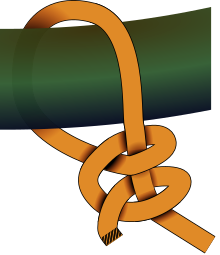Two half hitches
| Two half-hitches | |
|---|---|
 |
|
| Category | Hitch |
| Origin | Ancient |
| Related | Round turn and two half-hitches, Buntline hitch, Clove hitch, Taut-line hitch, Half hitch |
| Releasing | Binding |
| Typical use | General-purpose hitch |
| Caveat | low security. |
| ABoK | #1710 |
The two half-hitches is a type of knot, specifically a binding knot or hitch knot. It consists of an overhand knot tied around a post, followed by a half-hitch. Equivalently, it consists of a half-turn around a post followed by a clove hitch of the running end around the standing part.
This knot is also sometimes referred to as a clove hitch over itself, or double half-hitch.
Two half hitches is the commonest of all hitches for mooring in particular and also for general utility. Steel gives the name in 1794. The difference between two half hitches and the clove hitch is that the former, after a single turn around a spar, is made fast around its own standing part, while the latter is tied directly around the spar.
The following three-step process for tying the two half-hitches is also explained in the image gallery below. Click on the images for high-resolution versions.
Step 1: Form a single half-hitch, or overhand knot
Step 2: Form a second half-hitch above the first
Step 3: Tighten
To release the knot, pry apart the two hitches with a bending motion. However, it can often be difficult to untie. To help avoid this problem, tie a slipped variation: in the second half-hitch, pass through a bight, as when tying your shoe, rather than the entire free end.
The buntline hitch, when bent to a yard, makes a more secure knot than two half hitches, but is more liable to jam. It differs from two half hitches in that the second half hitch is inside instead of outside the first one.
...
Wikipedia
